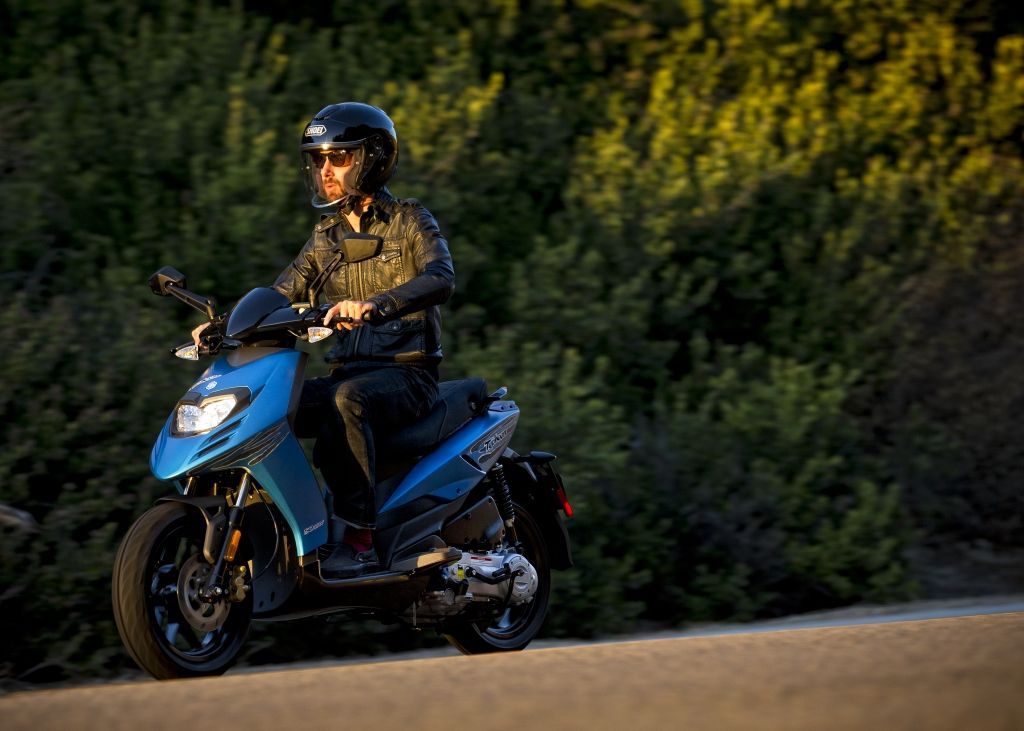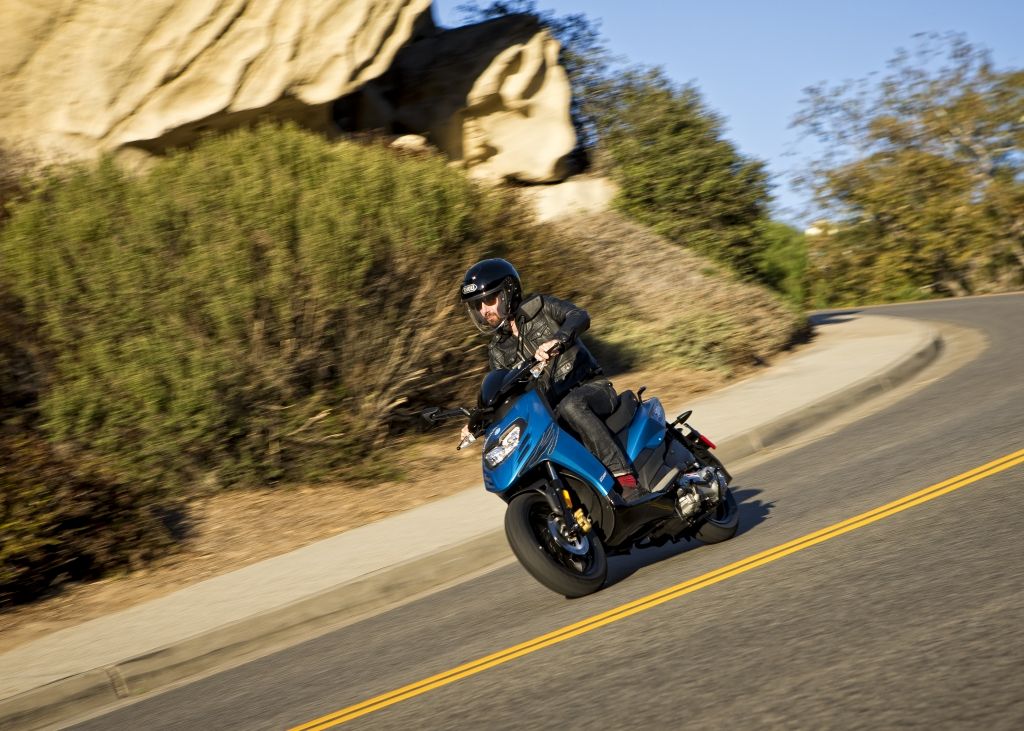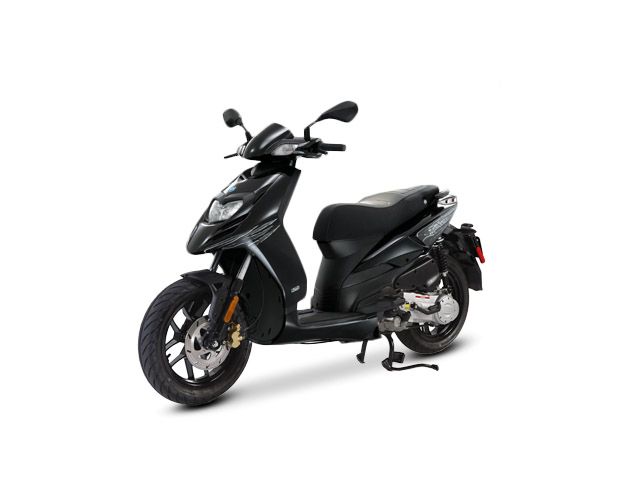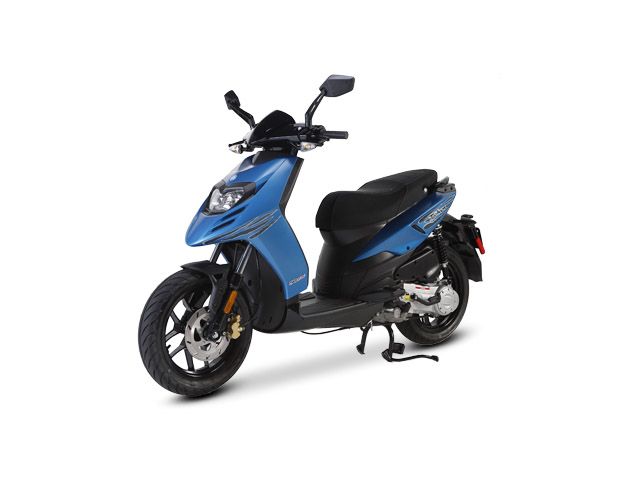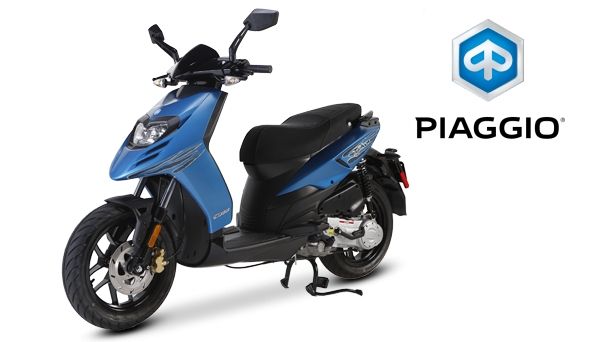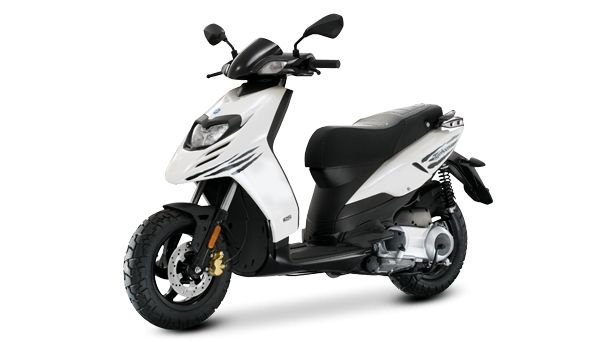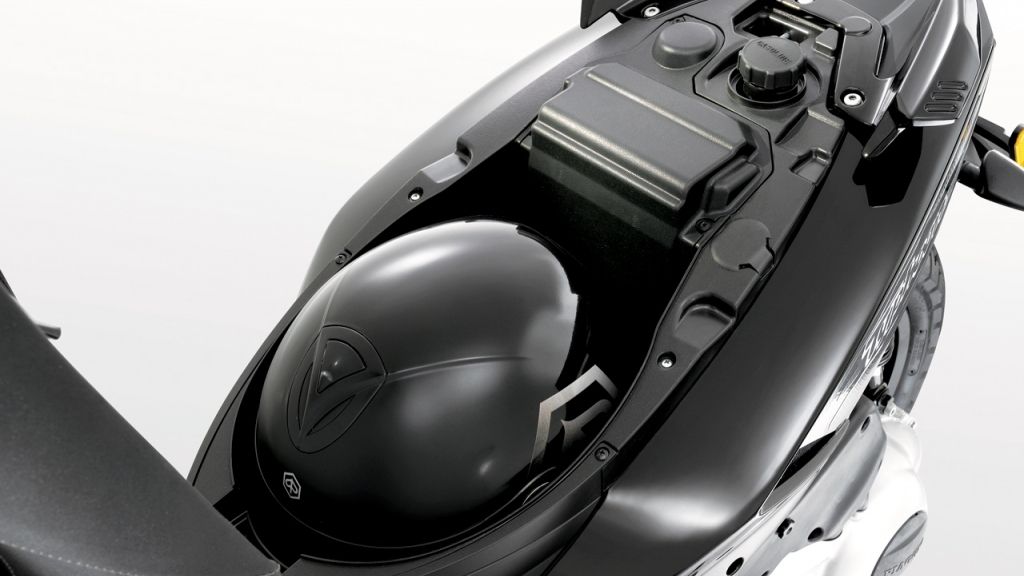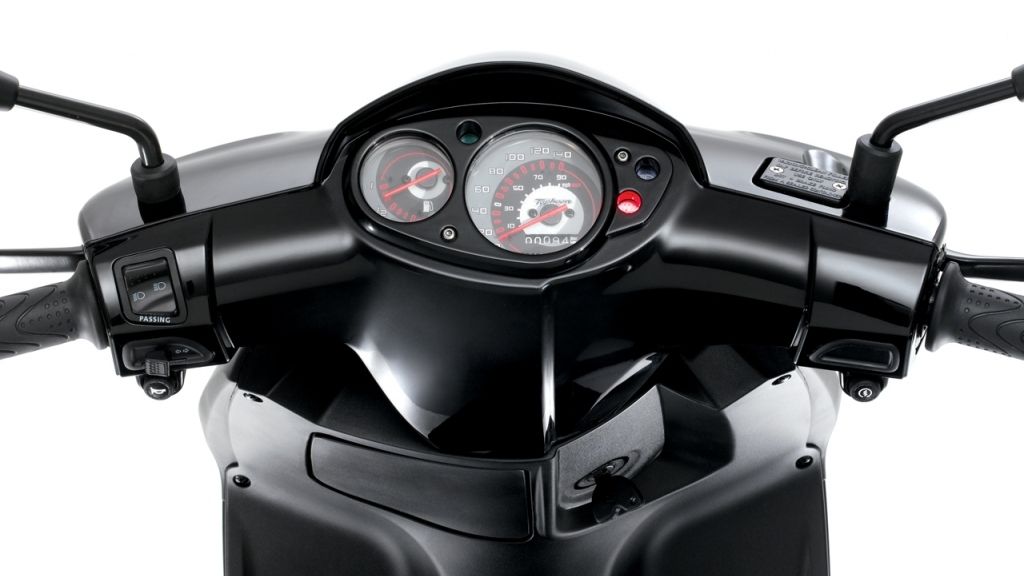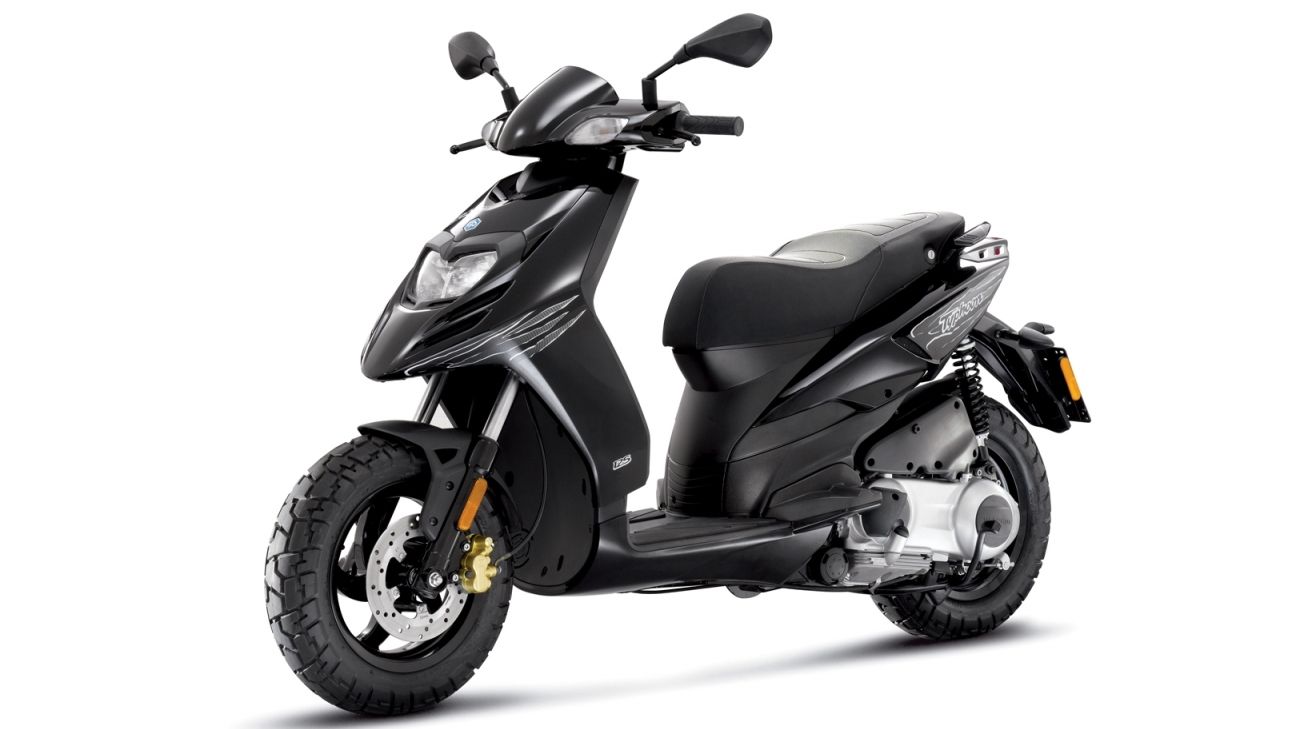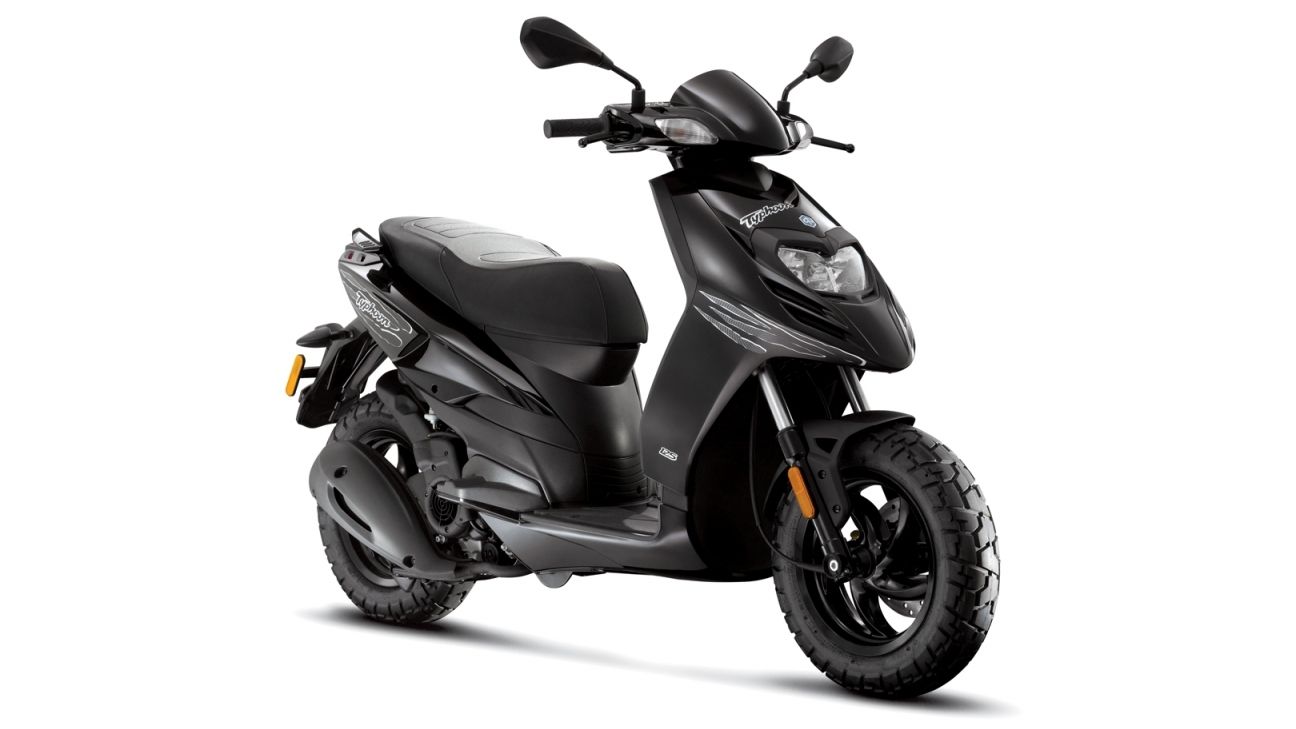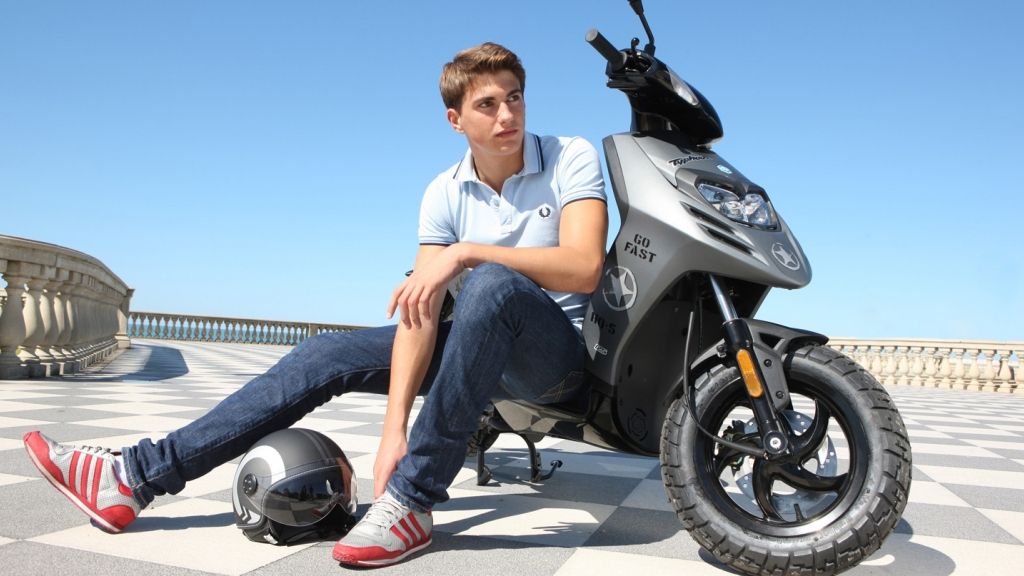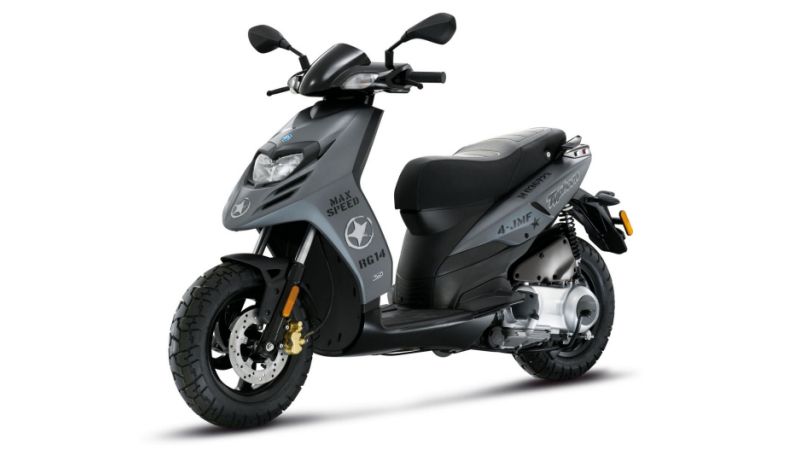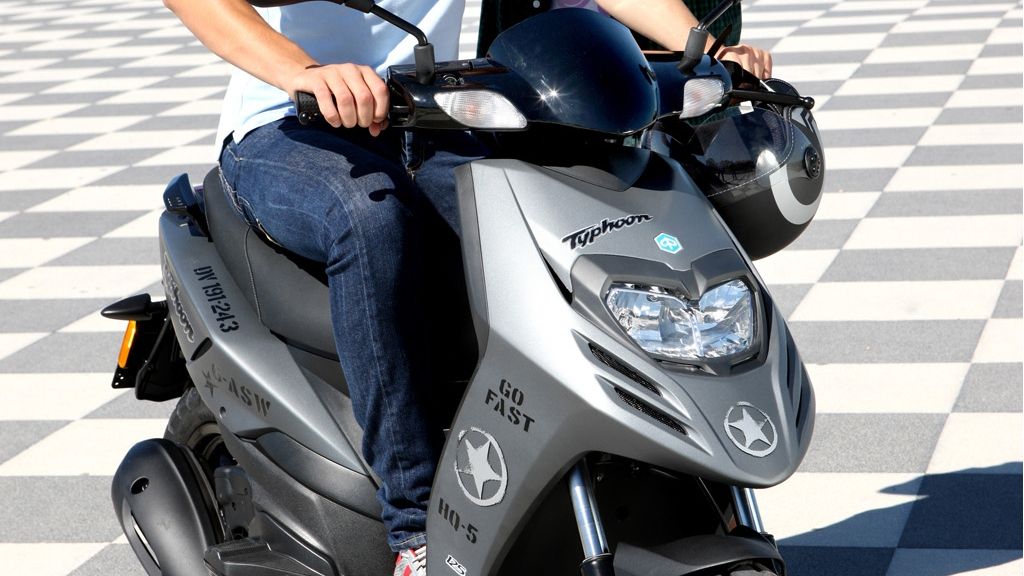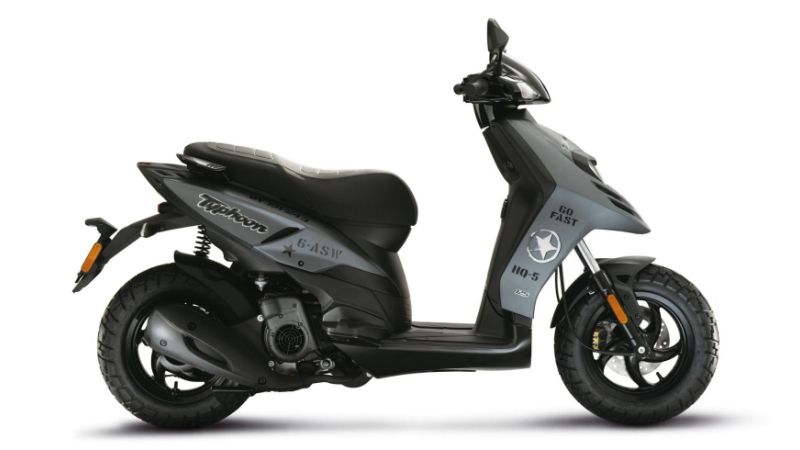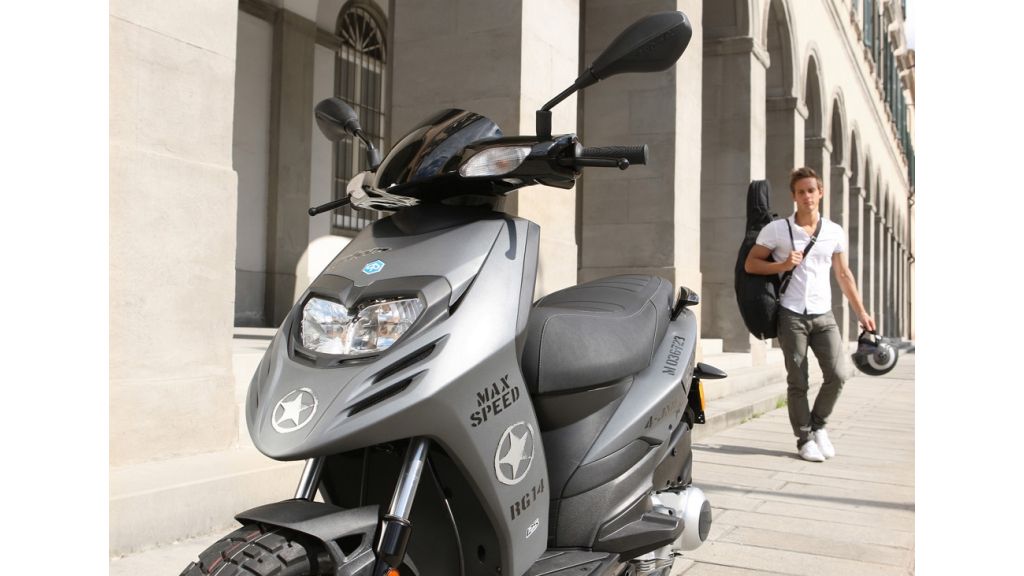Does it look familiar? It should. Overseas the Typhoon->ke5242 is marketed under the Gilera->ke2485 brand -- another of Piaggio->ke2268 groups -- with a two-stroke engine. Here it's the Typhoon 50 and its big brother, the Typhoon 125, under the Piaggio banner with four-stroke engines.
With its sport styling, the Typhoon is a little, lightweight scooter->ke2256 with some off-road->ke450 prowess -- maybe not off-road off-road, but at least a little rugged-dirt-road capable. That shark-nose front fairing gives it a bit of the sport-bike->ke631 aggressive appeal but with the convenience of a scooter.
Continue reading for my review of the Piaggio Typhoon 50 and Typhoon 125.
2016 Piaggio Typhoon 50 / Typhoon 125
- Make: Array
- Model: 2016 Piaggio Typhoon 50 / Typhoon 125
- [do not use] Vehicle Model: Array
Design
With fuel economy in mind, the 124 cc engine on the Typhoon 125 -- which is the same engine as Piaggio's 150 cc scooters but with a smaller bore -- is probably looking at about 65 mpg in the real-world. That comes in a bit lower than some of its 150 cc competitors since it doesn't have fuel injection. Remember the lack of alphabet-soup tech acronyms that keep the price low? EFI is one of them.
Instrumentation has taken a hit in recent redesigns. The old aeronautical panache of the instrument cluster has been replaced with a cheap-looking plastic set-up. I suppose that is in the vein of keeping the MSRP down. I guess, though, if you're going on budget, that sort of thing is to be expected.
Chassis
The Typhoon starts out with a double-cradle, trellis frame made of steel tubing. I prefer a proper underframe as opposed to a stressed-skin, monocoque structure. It's stronger, easier to make body repairs and allows for a full step-through with a nice,flat cargo deck between the rider's feet.
Frame construction between the 50 and 125 are almost identical, with the larger 125 model sporting an additional buttress around the engine mount to support the extra weight. Hydraulic forks cushion the front end, and a single, coil-over shock supports the rear from its offset position on the motor-side of the swing-mount drive unit, and it comes with a spring-preload adjustment.
A twin-pot front caliper binds the single, 220 mm front disc, and a 140 mm drum slows the rear wheel. Got to admit, I'm not a fan of drum brakes, but they are fairly ubiquitous in the scooter sector, and are generally good enough for the job -- as long as they are adjusted properly.
While the Typhoon 50 rolls on 14-inch street hoops, the 125 gets 12-inch tires that are what I like to call street-knobbies, which is to say deeply grooved for off-road grip with large flats for pavement traction -- bonafide dual-sport rubbers for the more adventurous scooter riders out there.
Drivetrain
Both engines are air-cooled, four-cycle thumpers with wet-sump lubrication and a single, over-head cam for valvetrain actuation. The 125 is electric-start only, but the 50 comes with both electric- and kick-start -- a feature I like for safety, and those instances where you just want to look cool in the parking lot while kicking your ride to life.
The Typhoon 50 actually displaces 49 cc, and it produces 2.8 pounds of grunt at 8,000 rpm, and a top speed of 40 mph, while the 125 measures out at 124 cubes, and cranks out 6 pound-feet at 7,500 rpm for a 60 mph max. Not exactly soul-crushing figures, but plenty for a ride that weighs in around 250 pounds, soaking wet.
As you might expect, the transmixxer is of the Continuously-Variable (CVT) variety, and it provides clutchless, twist-and-go operation for what I call a light pilot load, because there isn't much to think about as far as vehicle coordination goes.
Pricing
MSRP on the Typhoon 50 is $1,999 and comes in Neptune Blue and Shiny Black. The Typhoon 125 will set you back $2,599 -- $300 less than last year -- and comes Matte Silver and Graphite Black. Matte silver replaces the Cult White choice from last year. Your Typhoon comes with a two-year unlimited-mileage warranty and one year of roadside assistance provided by Road America.
Competitors
When looking for a competitor for the Typhoon 50 in looks and performance, I was first drawn to the SR Motard from Aprilia->ke1934. Wouldn't that be cheating, though, since they fall under the same parent umbrella and the only real difference between them, other than some cosmetics are …okay…nothing? It's the same scooter, so if color isn't a priority, Piaggio wins for being $100 less than Aprilia.
Let's look instead at the Zuma->ke4023 from Yamaha->ke301. Visually, the two are fairly dissimilar, unless you count that they both look like scooters, that is. The Typhoon has what Piaggio calls the “shark snout” fairing, and that is about what it looks like, but the off-road->ke450-styled Zuma 50F looks more like an “owl face” if you ask me, with the beak-like front fender and symmetrical headlamps staring out from the chassis.
Set up as more of a street ride, the Zuma FX sports a single-light front end. The Typhoon rolls on 14-inch hoops, but the Zuma tires are on 10-inchers -- a big blow for the Zuma, 'cause I like the tires on my ride to be bigger than those on my wheelbarrow. Both rides have a full step-throughs, though the Zumas have a closed-in channel running down the middle, so you might expect to have less between-feet cargo flexibility than you would get with a flat-deck step-through.
Engine size lines up at 49 cubes, and both run CVT-type transmissions. Yamaha claims 132 mpg from the Zuma 50 mill, while Piaggio ekes out a bit more with a claimed 144 mpg. Not a big difference, and certainly not a deal-breaker/maker.
Now, I don't get to say this very often, but the Piaggio comes in on the budget-conscious side of this equation at $1,999, just a bit under the Yamaha with its $2,590 sticker. Again, not a big difference, but it may matter to someone hard-up against an inflexible budget.
He Said
My husband and fellow writer, TJ Hinton, says, "It's not much of a difference, but I have to question Piaggio's decision to downsize the engine to 124 cc. It's such a small engine, and in the U.S., there's no displacement breaks for licensing so I don't know why they didn't just go with the 150 cc LEADER engine and save on the R&D by downsizing it."
She Said
"Storage isn't as spacious as some of its competitors, though there is still room for a helmet under the seat -- barely. I might be tempted to give up the between-the-feet cargo deck to move the fuel tank and free up the underseat storage. Maybe, I dunno."
Specifications
|
Model: |
Typhoon 50 |
Typhoon 125 |
|
ENGINE TYPE: |
4-stroke 4-valve |
Single cylinder 4-stroke |
|
CYLINDER CAPACITY: |
49 cc |
124 cc |
|
BORE x STROKE: |
39mm x 41.35mm |
2.2" x 1.1" |
|
MAX POWER AT SHAFT: |
4.6 hp(3.4 kW) at 9,500 rpm |
9 hp (6.8 kW) @ 8,500 rpm |
|
MAX TORQUE: |
2.8 lb-ft(3.8 Nm) at 8,000 rpm |
6 lb-ft (8.2 Nm) at 7,500 rpm |
|
Max speed: |
40 mph |
60 mph |
|
Fuel tank capacity: |
1.9 gals |
1.8 gals |
|
Gas mileage: |
144 mpg |
90 mpg |
|
Distribution: |
SOHC |
n/a |
|
Cooling System: |
Air |
Forced air |
|
Lubrication: |
Wet Sump |
n/a |
|
Ignition: |
Electric and kick starter |
Electric starter with automatic choke |
|
Gears: |
'Twist 'n go' automatic CVT |
'Twist 'n go' automatic CVT |
|
Clutch: |
Automatic centrifugal dry clutch |
n/a |
|
Chassis: |
High-strength steel single cradle |
Double cradle trellis made of high strength steel |
|
Front Suspension: |
Telescopic hydraulic fork, stroke: 76 mm |
Hydraulic telescopic fork with straight stanchions |
|
Rear Suspension: |
Engine acts as a swingarm, one hydraulic shock absorber with preload adjustment; stroke: 86mm |
Hydraulic single shock absorber w. spring preload |
|
Front Brake: |
220 mm disc brake with two-piston floating caliper |
220mm disc with dual-piston floating caliper |
|
Rear Brake: |
140 mm drum brake |
Drum 140 mm |
|
Front Tire: |
Light Alloy, Tubeless, 120/70 14" |
Tubeless 120/80-12" |
|
Rear Tire: |
Light Alloy,Tubeless, 120/70 14" |
Tubeless 130/80-12" |
|
Length: |
76.3" |
76.3" |
|
Width: |
28.3" |
28.3" |
|
Wheelbase: |
53.1" |
53" |
|
Seat Height: |
30.3" |
30” |
|
Dry Weight: |
242 lbs |
268 lbs |
|
Type Approval: |
EPA and CARB |
EPA and CARB |
|
ABS: |
No |
No |
|
Colors: |
Neptune Blue, Shiny Black |
2016: Cult White, Graphite Black, 2017: Matte Silver, Graphite Black |
|
MSRP: |
$1,999 |
2016: $2,899, 2017: $2,599 |


